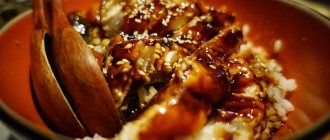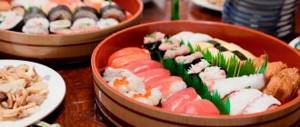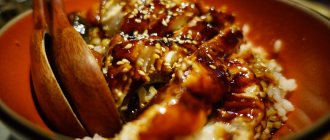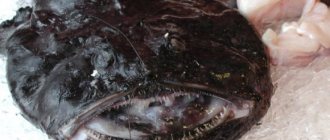Taiyaki
Almost all comedy and romance anime series feature a cheerful little girl eating taiyaki. But just because it's shaped like a fish doesn't mean it's a real fish. Taiyaki are rich cookies, sometimes made from wafer dough, that are shaped like a fish and filled with a sweet filling such as chocolate or red bean paste.
Although the origin of the fish shape is unknown, many speculate that the taiyaki shape is based on the prized sea bream. Thus, by purchasing this delicious delicacy in the shape of sea bream, customers feel like they are eating something extravagant.
Pie with herring from "Witch's Delivery Service"
It was baked by the courier-sorceress Kiki together with an elderly client - she wanted to please her granddaughter. The pie has a taste specific to a European gourmet, but at the same time the hand reaches out for another piece. The effect is largely achieved thanks to herring: canned fish, not lightly salted fish, has a mild taste and delicate texture. If you wish, you can replace it with tuna - the result will be approximately the same.
Ingredients:
- 300 g pumpkin;
- bulb;
- fresh herring or a can of canned fish in oil;
- a teaspoon of flour;
- a teaspoon of butter;
- a glass of milk;
- ready-made yeast dough;
- 4-5 olives;
- egg yolk.
Preparation
Cut the pumpkin into small pieces and steam it for 15 minutes, then remove the skin. Fry the onion in a frying pan until translucent and add it to the pumpkin. Mix the filling with a fork or masher until smooth and soft.
Prepare bechamel sauce - you will add it to the pumpkin puree. Melt the butter in a frying pan and fry the flour in it until golden brown, then gradually pour in the milk. Make sure there are no lumps left in the sauce.
Take a deep baking dish and fill it with the pumpkin and onion mixture. Cover it with fish, and that with a layer of dough. Decorate the future pie with stripes and “fish” from the dough, as well as olive rings. Brush the top with yolk, then bake the pie for 25-35 minutes at 180 degrees.
Onigiri
Onigiri, better known as rice ball, is a quick snack made from Japanese rice and often wrapped in seaweed. There are many ways to prepare the perfect onigiri—some people prefer to fill it with umeboshi (pickled plums), fish, jelly or meat.
This snack can be found in almost every anime series. The name onigiri was especially controversial when featured in Pokémon. Dabbers originally gave the snacks a name that audiences outside of Japan would be more familiar with and simply called them sandwiches. However, after backlash from fans, The Pokémon Company changed it to the more accurate "rice balls".
Bento from My Neighbor Totoro
The Japanese also take “ssoboyki” or “brakes” - food for their lunch break. They call it bento, and it's partly thanks to Asians that people love lunchboxes so much. The heroine of “My Neighbor Totoro” Satsuki did simple tricks that anyone can repeat. If you have trouble finding products, remember that they are easy to replace.
Ingredients:
- a portion of cooked rice;
- capelin;
- a handful of edamame beans (can be replaced with green peas);
- a teaspoon of katsuobushi - fish shavings (instead, you can finely chop dried squid);
- umeboshi fruit (a piece of soaked apple will do, but the effect will be different).
Preparation
Cook the cereal according to the onigiri recipe, then put it in your lunchbox. Fry 1-2 capelin until cooked and add the fish to the rice, as if dividing the grain into 2 equal parts. Decorate one of the rice “halves” with plums. Do the same with the edamame: boil the pods for 3-5 minutes, then remove the beans and place them in a lunchbox, covering one side of the rice. If you cook peas, remember that you need to cook them less.
On the remaining “empty” side with rice, add katsuobushi or pieces of dry squid.
Pocky sticks
Pocky is a popular Japanese cookie - a stick covered in chocolate. They come in a wide variety of flavors including strawberry, cream, melon, matcha green tea and more. So pocky is the perfect snack to share with anyone, anytime, anywhere. A great example is Yomi and Kagura from Ga-Rei Zero, who regularly share a Pocky box as a symbol of their friendship. But, if you are a true anime foodie, you won't share your pokes with anyone.
Breakfast mix from “From the Slopes of Kokuriko”
Look
Source:
Perfect serving of scrambled eggs.
0
Source:
Not the most exact copy of what was in the film, but the recipe can be varied. Just add some greenery! Recipe here.
Takoyaki
Takoyaki is the perfect snack for those who love seafood. The ideal way to prepare this Japanese snack is to fill the batter balls with boiled octopus (tako), diced, pickled ginger, green onions and other ingredients. On top of this delicious dish is a mixture of sauce, finely chopped vegetables and shavings of dried mackerel fish.
In Assassination Classroom, Korosensei makes takoyaki with the octopus that Karma killed. He gives it to Karma, who immediately spits out the overly spicy dish. You should be careful with spices.
Deep-fried Aji Furai mackerel from "From the Slopes of Kokuriko"
Look
Source:
Oh, how this oil boils...
0
Source:
Horse mackerel is a very tasty fish. Take a look at how to prepare it here.
Omuraisu
Season 1, episode 24, 08:00
Omuraisu is a dish from the category of yōshoku, that is, Japanese dishes created under the influence of Western culinary traditions. This is fried rice with vegetables that is coated or wrapped in an omelette and topped with ketchup. But even such a simple dish is not complete without grandma’s secret. First, you need to choose round (short grain) rice, since it contains more amylopectin, which is necessary for better sticking. Secondly, you need to fry the rice in small batches: this way it’s easier to achieve a beautiful color, as the chefs say. But perhaps the most important thing is the omelette. To make it light and silky, you need two movements at the stove. With your left hand, move the pan back and forth, and with your right, using chopsticks or a wooden spatula, constantly stir the egg mixture so that the whites curl, or coagulate, faster.
Japanese fresh baked goods (Yakitate!! Japan) 2004-2006
- Genre: anime, cartoon
- Rating: KinoPoisk - 7.4, IMDb - 7.8
- The plot about cooking immerses viewers in the intricacies of the craft of traditional Japanese bakers.
Self-taught village baker Kazuma Azuma has a large family. All family members work from an early age, helping their father with his work. The youngest son graduates from high school and goes to the capital of Japan. There he gets a job at the huge Pantasia bakery chain. The guy dreams of mastering the tricks of baking the perfect bread - Yappan.
Giant dumplings (ba-wan) from Spirited Away
Look
Source:
And no, you won't turn into a pig.
0
Source:
Ba wan is a Taiwanese dish that looks like jelly filled with meat, mushrooms or bamboo. Make sure you put in enough sauce! Recipe here.
Vegetarian ramen
Season 1, episode 16, 12:20
It would seem, is it really possible to surprise a Japanese with ramen? It’s like serving Olivier salad for New Year’s. However, this dish impresses tasters with its depth and balance of flavor, which Soma's father, Zeichiro, managed to achieve using soy sauce, yuzu juice, grilled carrots and turnips, burdock and lotus roots, chili oil, grated ginger and garlic. On top is tempeh, a popular fermented soybean product in Japan. But the coolest thing is that the ramen broth is made of soy milk and miso paste with grated taro tubers, which gave the whole dish a creamy depth. This can create a vegetarian version of ramen that is so rich in umami flavor that it can be mistaken for its chicken counterpart.
Food! Food! Food! Studio Ghibli Kitchen Comes to Life (Part 1)
Have you ever had such a feeling while watching an anime from Studio Ghibli that you were about to be touched by a gust of wind, sea spray and... the incredible smell of food that the on-screen characters gobble up with such pleasure?
Is it worth continuing to drool over your keyboard when you can cook exactly the dish that appears in the frame yourself? And rest assured that the taste will not disappoint you!
We present to you 6 delicious recipes from Hayao Miyazaki (part 1):
Rice porridge (okayu) from the anime "Witch's Delivery Service" and "Princess Mononoke"
Rice is the basis of the Japanese daily diet, and they eat it completely bland, without additives or oil, as we are used to. Therefore, okaiu is nothing more than round white rice (like our “Kuban” variety) pre-soaked in cold water. It is prepared to remain crumbly, but still cooked through and soft.
Of course, you can add anything to the finished rice, but chopped onions will make it look like what the prince and the wanderer ate on their journey and from “Princess Mononoke.”
Ingenuous isn't it?
Breakfast "From the Slopes of Kokuriko"
Essentially, this is the same ready-made okayu, only fried (as in the photo) with soy sauce and used as the basis of the dish. Next, slices of fried sausage and fried eggs are laid out on it.
The film had a green salad as a side dish (I assume it was Iceberg lettuce with butter, salt and lemon juice), but you can also sprinkle it with onions (apparently the Japanese really love onions).
Fried egg with bacon from Howl's Moving Castle
Fresh chicken eggs, bacon and chopped and fried onions, seasoned with cumin and wine vinegar - this is a simple but incredibly tasty breakfast for those who still have a lot to do during the day.
The main thing is not to inadvertently feed eggshells to your human stove.
Ramen from Ponyo on the Cliff
Ramen is an Asian wheat noodle that often doesn't even need to be cooked. Just pour boiling water or meat broth over it for a richer taste.
A slice of ham, half a boiled egg and chopped onion will decorate the dish and make it the same as what Ponyo and Soosuke ate.
Kiki and Zizi's breakfast from "Witch's Delivery Service"
A fresh pancake, fried black pudding, a piece of cheese or fresh vegetables - there can be a great many variations on the theme if you have enough imagination in your head and a variety of products in the refrigerator.
Of course, fresh crusty bread and black coffee are the best addition to a little witch's breakfast, especially if your talking black cat likes the same thing.
Winter vegetable stew (nimono) from Laputa Castle in the Sky
This recipe, although imbued with Japanese aesthetics, is overall as simple as five cents.
Ingredients for nimono:
- 400 ml. aromatic unsalted broth (meat or vegetable);
- 2 medium peeled carrots;
- 1 large peeled onion;
- 5-6 medium champignons (the Japanese prefer shiitake mushrooms);
- For decoration/garnish, something small and green like peas or small broccoli is suitable.
And to make the dish truly Japanese, we will need:
- Sesame oil;
- sugar;
- sake (Japanese vodka);
- mirin (sweet analogue of sake);
- soy sauce;
- salt.
How it's done:
We need to cut the carrots as in the photographs:
Cut the potatoes as in the photographs, cutting off the sharp corners from the pieces (otherwise they will boil and become mashed) and soak in cold water so that the starch comes out of the slices:
Cut the onion lengthwise into 8 wedges and cut the mushrooms in half.
In a saucepan with thick walls (they can be aluminum or cast iron), you need to pour a little sesame oil and throw onion slices inside, fry for 2-3 minutes until it becomes a little transparent around the edges.
Throw in the carrots and potatoes and heat the vegetables for another 2 minutes.
Add the mushrooms and simmer for a couple more minutes.
Pour the broth into the saucepan so that it completely covers the vegetables (but there should not be too much of it, otherwise it will not be a stew, but a soup).
Bring the stew to a boil and reduce the heat to medium. We will need to remove any foam that appears so that the broth is clear.
Add seasonings in this order:
1/2 tbsp. sugar -> 1 tbsp. sake -> 1 tbsp. mirin -> 2 tbsp. soy sauce
Cover the stew with a lid and leave to simmer for 20-30 minutes over medium heat. After 10 minutes, you can stir the vegetables so that they cook evenly.
When the nimono is ready, you can decorate it with something green and beautiful (yes, peas or broccoli). The dish may need to be seasoned or soy sauce added.
You can store the stew in the refrigerator for several days and it will not lose its taste, but on the contrary, it will become even more rich and aromatic.
Whatever you say, my mouth watered. And you?
Mona © YesAsia
Confectionery "Antikva" (Antîku: Seiyô kottô yôgashiten) 2001
- Genre: drama
- Rating: KinoPoisk - 7.6, IMDb - 7.8
- The storyline tells about the work of a private confectionery shop. It only has 2 employees.
The anime about chefs begins with Tachibana Keiichiro being fired from a prestigious job of his own free will. By the age of 30, the hero realized that it was time to realize his old dream. He opens his own pastry shop. He also invites pastry chef Yusuke Ono to join the staff. He trained in Paris and was awarded the title “King of Cakes.”
Foodgasm in anime: 10 recipes from the series “In Search of the Divine Recipe”
In 2015, an anime adaptation of the Japanese manga series "Shokugeki no Sōma" - "In Search of the Divine Recipe" - was released. The third season started this fall. Afisha Daily asked Seva Ostakhnovich, the author of the Food & Science telegram channel, to explain why you need to watch it right now.
Seva Ostakhnovich
Author of the telegram channel @foodandscience, sociologist, cook, traveler, admirer of the scientific approach in the kitchen
Shokugeki no Sōma is the story of a boy, Soma Yukihira, who, with a dream of surpassing his father in cooking, ends up at the elite Totsuki Culinary Academy, where he, along with other gifted chefs, undergo a series of cooking tests and fight in chef battles. Such battles are called shokugeki. If the dish is excellent, the judges who accept it experience foodgasm: the character turns red, screams with pleasure and flies off somewhere upward. Naturally, at the same time, all his clothes are torn off, and the main ingredient of the prepared dish envelops, hugs, covering his intimate areas, or simply bursts forth, as in this video below.
But don't let this scene fool you: this is not hentai for adults, but a real manual for chefs. Such food gasses are just a “commercial argument.” The main thing in this anime is still food and its preparation. This is a serious work, co-authored by Yuki Morisaki, a chef, model and writer, who made a huge contribution to the development of the series.
I'll tell you about 10 dishes from the series that will make you throw away your skepticism and start watching "In Search of the Divine Recipe" today.
Three states of the egg
Season 1, episode 14, 03:30
Three states of the egg of the main representative of modernist cuisine in this series, Alice Nakiri. A “raw egg” consists of thickened seawater and caviar in a gelatin bubble. The Hard-Boiled Egg is an egg-shaped asparagus mousse with chilli and black pepper hollandaise in the center. “Egg in the Shell” is a caramel-cream cocktail served with a straw. To serve this, make a small hole in the egg, pierce the yolk with a toothpick and pour the contents into a blender, where the caramel and milk are already waiting. Whisk and carefully pour back into the egg through the funnel. Serve with a straw. You will never want to drink an egg any other way.











